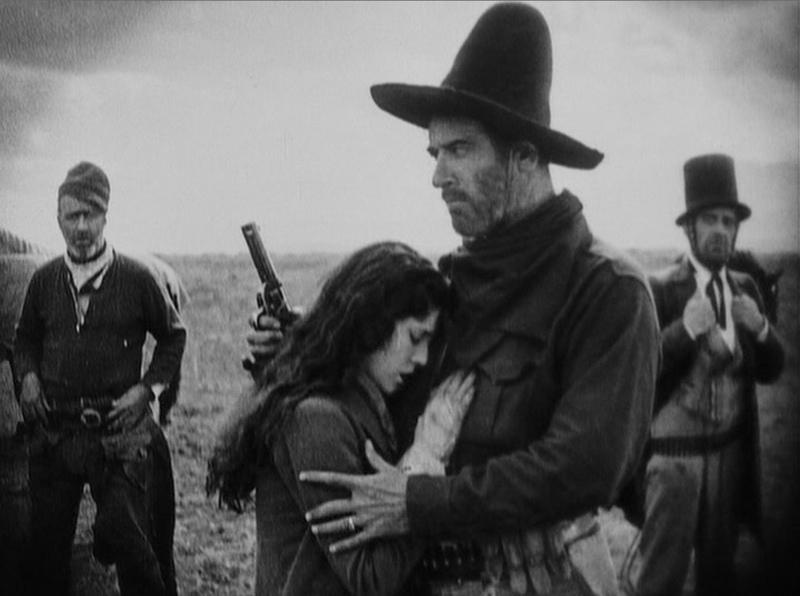The Silent Screen Spectacle Of The Silent Spectacle Western
DIRECTED BY JOHN FORD/1926
STREET DATE: August 23, 2016/KINO LORBER
 2/3rds of the way through director John Ford’s final silent Western, a cavalry officer peers through his binoculars for a solid 25-seconds-long, far-distance panning shot across what appears to be a mile-long line of covered wagons, carriages, horses and their riders. Recreating in screen-spectacular detail the 11:59 moment that commenced the June 25th, 1877 Land Rush at Custer City, the 12 o’clock noon signal of a cannon’s roar shows hopeful settlers and gold prospectors flooding the Dakota Territory on every mode of vehicle then-conceivable – from a horse-drawn platform carrying a mounted newspaper printing press to a three-feet-high boneshaker bicycle comically careening across the plains – in order to “claim” their parcels of land that had just moments before been the province of the recently-relocated Sioux tribe. A moment of living, breathing history, the silent spectacle Western 3 Bad Men reaches across nearly 5 decades of American history and, with this almost mythic sequence, dramatizes its borders being pushed ever-Westward along its ever-diminishing frontier.
2/3rds of the way through director John Ford’s final silent Western, a cavalry officer peers through his binoculars for a solid 25-seconds-long, far-distance panning shot across what appears to be a mile-long line of covered wagons, carriages, horses and their riders. Recreating in screen-spectacular detail the 11:59 moment that commenced the June 25th, 1877 Land Rush at Custer City, the 12 o’clock noon signal of a cannon’s roar shows hopeful settlers and gold prospectors flooding the Dakota Territory on every mode of vehicle then-conceivable – from a horse-drawn platform carrying a mounted newspaper printing press to a three-feet-high boneshaker bicycle comically careening across the plains – in order to “claim” their parcels of land that had just moments before been the province of the recently-relocated Sioux tribe. A moment of living, breathing history, the silent spectacle Western 3 Bad Men reaches across nearly 5 decades of American history and, with this almost mythic sequence, dramatizes its borders being pushed ever-Westward along its ever-diminishing frontier.

The 3 Bad Men of the title are “Bull” Stanley (Tom Santschi), “Spade” Allen (Frank Campeau), and Mike Costigan (J. Farell MacDonald): a trio of “wanted men” who have blazed a trail of wickedly apparent, but never explicitly shown wrongdoing across the Wild West. As the drama commences, this wild bunch’s nobler impulses are quickened, however, when they encounter a young woman, Lee Carleton (Olive Borden), at the site of a rival gang’s murderous attack upon her father’s Westward-moving wagon. Employing the three ruffians as bodyguards, of sorts, they resolve to play matchmakers, of equally dubious sorts, for Miss Carleton when the wagon train alights at their Land Rush destination of Custer City; eventually employing tough Irish beefcake Dan O’Malley (Ford favorite leading man of the period George O’Brien) as one they deem “worthy” of their eminently eligible young female employer. Mixing sentiment and spectacle in the inimitable Ford fashion – with subplots involving a white-hatted, whip-carrying screen dandy of a Western villain in corrupt Custer City sheriff Layne Hunter (the much-storied silent-screen matinee idol Lou Tellegen; look him up!) and a dramatic, D.W. Griffith-like fiery siege on the unoffending frontier church of good Rev. Calvin Benson (Alec B. Francis) – 3 Bad Men is grand ol’ Western entertainment writ large, with the warm and broadly-comical character bits – especially from the titular trio – expertly balancing the broader historical canvas upon which Ford paints his distinctive, landscape-oriented vision of The West.

Kino Lorber’s Blu-ray release of one of the silent screen’s last Super Westerns – a genre that commenced with Paramount’s 1923 release of James Cruze’s The Covered Wagon, continued through John Ford’s own massive railroad epic The Iron Horse (1924), and culminated with popular screen cowboy William S. Hart’s final-starring role in Tumbleweeds (1925) – will, I hope, highlight this ambitious and adventurous period of silent-era filmmaking when Hollywood studios attempted to take the genre beyond its Saturday morning-matinee and dime store-novel trappings and instead raise these pistol-packing, canyon-riding adventures to the level of American Epics. As pointed out by Ford biographer Joseph McBride, in an informative and perceptive commentary track accompanying the film, 3 Bad Men was Ford’s last Western until his 1939 masterwork Stagecoach, and plays in retrospect as a summation of the smaller scale Westerns he had made before – in, for instance, scores of Westerns starring the iconic Harry Carey – and further looks forward to the Westerns he would later essay when he resumed the genre with the incomparable My Darling Clementine (1946), Fort Apache (1948), She Wore a Yellow Ribbon (1949, and, eventually, his all-time masterpiece of The Searchers (1956).

Taken from the best source elements available, this 90-year-old film shows the wear of its years in parts – the inevitable screen lines and blotches inherent from a years-later-discovered, sole-extant print – but the Blu-ray nonetheless gives the film its best possible visual presentation, and the previously-described screen spectacle of this silent Western shines through every frame. Moreover, the 2007 score accompanying this release, composed by Dana Kaproff, is a wonderful accompaniment to the film, mixing both contemporary and period-sounding solo-piano and solo-guitar tracks with orchestral music, and serves to enliven the proceedings in the most effective silent-scoring manner. What more can I say? If you love Westerns, silent cinema, and screen spectacle, Kino Lorber’s Blu-ray of 3 Bad Men is your essential home video choice.
The images and promotional material used in the review are present only as a reference to the film and are not meant to reflect the actual image quality or content of the Blu-ray.

